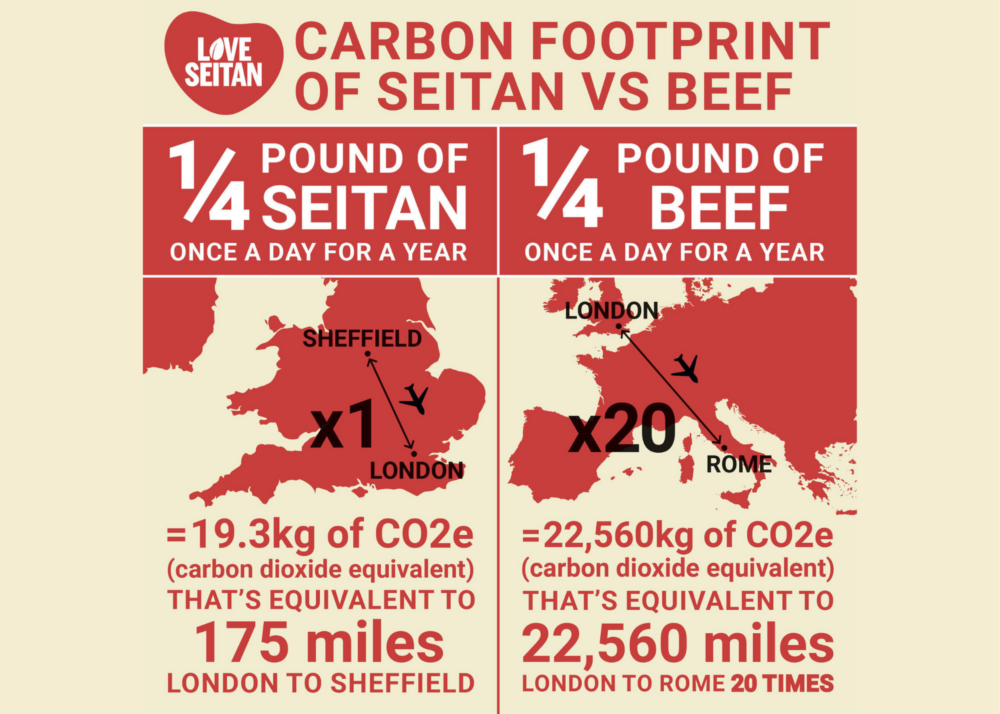
¼ POUND OF SEITAN PER DAY COSTS JUST 19KG OF CO2 A YEAR (less than one tree’s worth)
14th July, London, UK – LoveSeitan, the UK’s leading manufacturer of seitan products, today releases new data from an analysis by Thrust Carbon revealing how eating a ¼ pound of seitan a day instead of ¼ pound of beef each day saves as much carbon as 10.6 return flights to Rome per year (22,560 miles of flying).
The data shows how if one person were to eat a ¼ pounder burger of LoveSeitan’s seitan once a day for a year, the total carbon footprint would be a mere 19.3kg of CO2e (carbon dioxide equivalent). To put this into context, the average tree captures over 20kg of CO2 a year. In terms of flight distance, this would account for just 175 miles of flying (which would be just enough for a one-way flight from London to Sheffield), a tiny 0.78% of the flight distance equivalent for eating beef at the same rate.
Instead, if someone were to eat a ¼ pounder burger of beef once a day for a year, the total carbon footprint would be a whopping 2,483.4kg of CO2e (carbon dioxide equivalent) – the same footprint as 10.6 return flights to Rome from London (22,560 miles of flying).
Throughout the analysis, plant-based foods scored a much lower carbon footprint than animal products, with tofu producing just 300kg of emissions per 100kg of tofu. But seitan has a much smaller footprint by far, with just 46.6kg per 100kg of seitan.
Commenting on the new emission comparison analysis, Co-Founder of LoveSeitan, Steve Swindon, said: “Now is the time to switch to more sustainable food sources. We can’t continue down this road where animal products are part of every meal. I don’t see how anyone could look at this data and not want to cut animal products, particularly beef, out of their diet. The evidence is clear and I hope it nudges people in the right direction towards a healthier, more sustainable diet that is kinder to animals.
“If you’re eating a quarter pound of beef once a day for a year, that’s the equivalent of taking over 10 return flights to Rome every year. In contrast, you can eat exactly the same amount of seitan and it only costs 19kg of CO2 – less than the equivalent to what one tree draws down per year and only enough to get you one way from London to Sheffield.”
These new findings will support launch of the first ever ‘World Seitan Day’ (which will take place on October 18th, 2021 – the birthday of George Ohsawa) – a new initiative to celebrate seitan as the world’s most versatile and sustainable vegan meat, and honour George Ohsawa (born on October 18th 1893), from Japan, the first person to ever coin the term ‘seitan’.
Hand-crafted for excellent taste and a satisfying texture, LoveSeitan’s products are made with healthy nourishment in mind:
- Just 100g provides:
- Protein: 28g
- Fat: 1.2g, of which 0.2g is saturates
- Carbs: 8.8g, of which 0.6g is sugars
- Salt: 1.5g
- Fibre: 2.6g (over 3g for Smokey Dokey and Seitan Pepperoni)
- B12: 1.3 micrograms.
- Daily requirement according to the NHS website is 1.5 micrograms
About LoveSeitan
LoveSeitan is the UK’s leading manufacturer of seitan, a wheat based vegan meat which has been around for the last 1,500 years. Seitan provides a healthy, low fat, plant based, protein rich food for vegans, vegetarians, and flexitarians alike. The LoveSeitan team has developed a unique process for making seitan with unrivalled texture and flavour in their fully vegan, BRC accredited facility. In addition to serving the public through their online shop, LoveSeitan supplies food service businesses, manufacturers, wholesalers, distributors, restaurants, cafes and retail outlets.
Seitan itself dates back to ancient China, almost 1,500 years ago. Buddhist monks in the sixth century discovered the ‘wheat meat’ after rinsing wheat dough with running water, removing all the starch, leaving a high protein wheat gluten. Ancient folklore suggests that the Buddhist monks behind the discovery used seitan to encourage followers to adopt a meat-free diet, offering the ‘wheat meat’ as an alternative to killing and eating animals.
Despite the ancient history, the term ‘seitan’ wasn’t used until the early 1960s. The term originates from the combination of two words: sei, meaning “made of” or “proper/correct” and tan, the first character in the Japanese word tanpaku, which means “protein.” It was coined in the early 1960s by the Japanese philosopher and founder of the macrobiotic diet George Ohsawa (1893 – 1966) who brought seitan to the West in the early 1960s.
World Seitan Day will take place on October 18th every year, Ohsawa’s birthday, and will celebrate the food’s versatility and honour Ohsawa’s memory.
Building on the momentum of recent growth and the announcement of World Seitan Day, LoveSeitan’s overall goal is to make sure seitan is as healthy, tasty, accessible and sustainable as possible. Seitan has proven to be the perfect choice for vegans searching for a meat alternative in recent years, and is continuing to surge up the ranks of the most popular vegan meats in Europe. Vegans, vegetarians, flexitarians and meat-eaters alike are becoming seitan fans thanks to its meaty texture and healthy ingredients.


Wow! Why hasn’t someone made a visual like this on a US map?